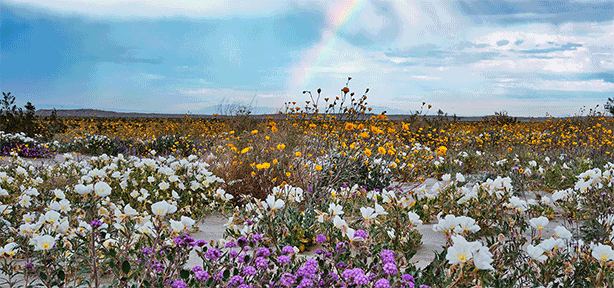SACRAMENTO, Calif. – With spectacular wildflower blooms expected this spring that may attract thousands of people into the outdoors, California State Parks is providing visitors with tips on how to explore the blooms safely and responsibly. In the interest of safety and conservation, visitors are asked to understand the area they plan on visiting, check the weather, respect the landscapes and know their body limitations. Following these simple tips can positively increase the experience for all wildflower bloom enthusiasts.
In 2017 and 2019, colorful arrays of super blooms carpeted Antelope Valley California Poppy Reserve State Natural Reserve (SNR), Anza-Borrego Desert State Park and Ocotillo Wells State Vehicular Recreation Area (SVRA), attracting hundreds of thousands of people from around the world to view the spectacular blooms. These rare and unpredictable wildflower blooms occur when high precipitation levels in natural landscape areas are combined with a yearslong drought, which eliminates grasses and weeds that take up nutrients. Since California was fortunate to receive more rain last fall and this winter, public land managers are expecting “good” to “better-than-average” wildflower blooms in spring, depending on the continued weather conditions. Depending on the park, visitors may see colorful California poppies, sand verbena, desert sunflowers, evening primrose, popcorn flowers or desert lilies.
“If the state is lucky to be adorned with wildflower blooms this spring, we want to make sure that everyone has a positive experience when exploring them,” said State Parks Director Armando Quintero. “California State Parks welcomes all to enjoy these unpredictable, rare occurrences but asks visitors to ‘Don’t Doom the Bloom’ by staying on designated trails and taking only photos, not flowers.”
Below are some tips and park rules to make viewing the wildflower blooms more enjoyable:
Understand the Area
- Cell coverage can be spotty or nonexistent in some parks—be prepared.
- Read about your state park destination online and download a map prior to your visit, especially if you are visiting a desert. Many GPS and map apps will take you to dirt roads requiring four-wheel drive vehicles.
- Know your vehicle’s limits. Know which areas allow off-highway vehicle recreation.
- Visit the parks during the week and arrive early to beat the crowds.
- Remember to pull off the roadway when viewing wildflowers, wildlife or to take photos. Please leave roadways clear for vehicle traffic.
- Leave an itinerary of your trip with a family member or friend with information such as time of departure and expected return, site visit location and names of everyone in your group. This will ensure law enforcement personnel have a better understanding of your location in the event of a rescue.
Check the Weather
- While planning your trip, check weather conditions. Be prepared and plan for all types of weather.
- Make sure your equipment and clothing are appropriate for the expected weather.
Respect the Landscapes
- Each park has unique landscapes. Stay on designated trails whenever possible. Tread lightly in the desert. Do not trample flowers.
- When viewing the blooms, take only pictures. Flower picking is prohibited.
- If dogs are permitted, they must remain on leash, on designated roads, in campgrounds and in picnic areas. Dogs are not allowed on hiking trails, in the backcountry or in the wildflower fields. Do not leave dogs unattended in your vehicles—temperatures can reach lethal levels.
- Drone use may be prohibited. If drone use is allowed, a filming permit from individual state park units must be requested.
- Help keep the landscapes pristine, leaving it better than when you arrived by packing out anything you packed in—pack it in, pack it out.
Know Your Body Limitations
- Bring plenty of food and water. There are often no restaurants, gasoline stations or stores near the bloom areas.
- Drink plenty of water prior to your visit to remain hydrated and avoid heat-related emergencies.
- Outdoor conditions can change quickly, especially in the desert. Bring sunscreen, a hat, layers of clothing and closed-toe shoes to avoid injury.
- Walk at a pace that allows you to talk easily. If you are too out of breath to speak, you are probably working too hard. Take a rest or stop exercising.
- In the event of an emergency, call 911.
Although wildflower blooms may adorn many areas in California, some of the most beautiful blooms take place in desert landscapes. Some areas in the extreme southern part of San Diego County are currently seeing small regional pockets of blooms in parts of Anza-Borrego Desert State Park, and future desert weather and temperature shifts, especially in the month of February, may help or hinder the expansive wildflower spread. If the weather shifts to warmer and drier days, the winter annual bloom may be over in a few short weeks.
A popular area that has previously seen a spectacular bloom is the Antelope Valley California Poppy Reserve SNR, which expects to have a better-than-average bloom from March to May. Sporadic individual poppies are already starting to bloom. Poppy plants have sprouted throughout the Poppy Reserve in large, dense quantities. If the weather remains mild, the bloom is expected to be better this year. If the weather turns hot, this could affect the bloom in the next few months. Other parks expecting good wildflower blooms during the same time include Red Rock Canyon and Chino Hills State Parks and Eastern Kern County Onyx Ranch SVRA. Additionally, Hungry Valley SVRA and Fort Tejon State Historic Park are also expected to have larger blooms later in the spring season.
Detailed information on this year’s potential wildflower blooms and park rules, in Spanish and English, is available online at parks.ca.gov/WildflowerBloom.
California State Parks and the recreational programs supported by its divisions of Boating and Waterways, Historic Preservation and Off-Highway Motor Vehicle Recreation provide the opportunity for families, friends, and communities to connect. Off-highway motor vehicle recreation, boating activities, horseback riding, cycling, hiking, camping, rock climbing, tours, hikes, school group enrichment, and special events are just some of the activities enjoyed in 280 park units organized into 21 field districts throughout the state. Learn more at www.parks.ca.gov.

